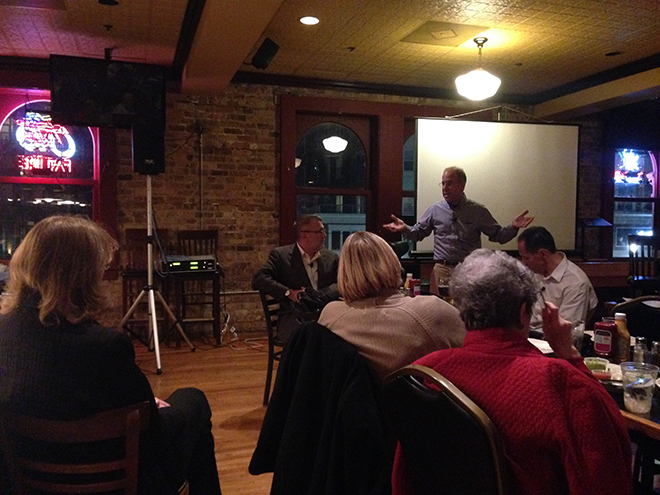
Northwestern University students and Evanston residents gathered at the Firehouse Grill in south Evanston on Tuesday night to hear three out of the eight members of the John Evans Study Committee speak on the results of their research.
Professor Carl Smith, Professor Andrew Koppelman and Professor Peter Hayes were a part of a team that investigated whether or not John Evans, the founder of Evanston and one of the founders of NU, was involved in the Sand Creek Massacre, in which over 100 Cheyenne and Arapaho Indians were killed in the Colorado territory. The results of the study were published last May.
The panelists held the committee in an attempt to spread public awareness about their research and John Evans' impact on the community.
"He did a lot of good things for the university and gave a lot of money – tainted money," said Smith, a history professor. "I think at the very least [Northwestern] should make the report public, talk more about the full record including its failures.”
At the panel discussion, the speakers quickly skimmed over their book of research findings to the 40 attendees. Evans, they said, has left an imprint of his name all over campus and the city. A projector screen displayed old yellowed photographs of Evans, his mentors and fragments of his legacy on campus.
Evans left Evanston for the Colorado territory to become governor and superintendent of Indian Affairs. In response to the political turmoil following the Sand Creek Massacre, President Andrew Jackson asked him to step down, after which he served as a Northwestern board trustee for 40 years.
In 2013 a petition by the Native American and Indigenous Student Association (NAISA) called for the investigation of the seemingly forgotten Evans and his role in the Sand Creek Massacre.
“One of the things that I found striking a few years ago when I visited downtown Berlin is how forthright they are about the history,” says Koppelman, professor of Political Science at NU. “Some pretty bad things happened in Berlin and you can’t walk around and not know about them. Before this committee made this report, if you read NU’s material on Evans you wouldn’t have a clue that this was apart of his story. I don’t think that will be the case in the future, it shouldn’t be the case.”
Following the results of this committee, a second committee consisting of students, faculty and community members, will deliberate further action and response to the report. Some panelists discussed ideas included adding a Native American Studies program or a speech highlighting the committee report. The group was in consensus that a better education of Evanston and university history should be implemented.
“I think a big part of the problem is the student climate on campus, a lot of people don’t want to hear that their school founder is implicated in a massacre," said Forrest Bruce, co-president of NAISA. "It's unnerving and I think a lot of people shy away from it.”